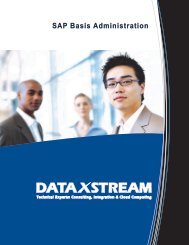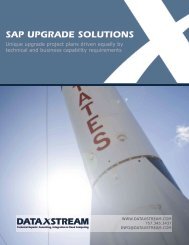Lumber Liquidators - DataXstream
Lumber Liquidators - DataXstream
Lumber Liquidators - DataXstream
Create successful ePaper yourself
Turn your PDF publications into a flip-book with our unique Google optimized e-Paper software.
insiderprofiles.wispubs.com Reprinted with permission from the APR MAY JUN 2011 insiderprofiles
This article appeared in the APR MAY JUN 2011 issue <br />
of insiderPROFILES (http://insiderPROFILES.wispubs.com) <br />
and appears here with permission from WIS PUBLISHING.<br />
How <strong>Lumber</strong> <strong>Liquidators</strong> Optimized Its IT Investments<br />
and Lightened the Demand on Its IT Organization<br />
by David Hannon, Features Editor<br />
Rapid business growth is a double-edged sword. On one hand,<br />
all emerging enterprises surely aspire to grow and thrive. But<br />
keeping up with this expansion, especially from an infrastructure<br />
point of view, can be complex and expensive. In less than<br />
two decades, hardwood flooring retailer <strong>Lumber</strong> <strong>Liquidators</strong><br />
grew from a single warehouse with no running water to<br />
a $600 million retailer with stores in 46 US states and more<br />
than 1,000 employees.<br />
In 2009, <strong>Lumber</strong> <strong>Liquidators</strong> planned to open 30–40<br />
new locations — and expected similar results for 2010. To<br />
accommodate this growth, the business required some major<br />
IT infrastructure changes. To this end, the business opted<br />
to implement a new ERP system, selecting SAP ERP for its<br />
functionality extending across finance, sales and operations,<br />
warehouse management, merchandising, and purchasing.<br />
Because the company was interested in a cost-efficient ERP<br />
system, the implementation team began an evaluation process<br />
to find a flexible server architecture that could handle its<br />
current requirements and also scale as the business continued<br />
to expand — especially in the areas of order capacity, transaction<br />
speed, reporting, and process automation.<br />
“Our goal was to deploy a solid and manageable foundation<br />
with the ability to scale,” says Jack Kinsey, Director of Network<br />
Operations at <strong>Lumber</strong> <strong>Liquidators</strong>. “The message from the<br />
top of our company was to continue to deliver the way we’re<br />
delivering, but to keep an eye toward the future.”<br />
Moving to a Virtual Environment<br />
A conservative estimate from an internal cross-functional<br />
search committee showed that, to run a new ERP system, the<br />
company would need to triple its number of physical servers<br />
— and would then have to add more servers in the future as<br />
the landscape expanded.<br />
“We didn’t have a data center available in which we could<br />
put that much additional equipment while maintaining a<br />
reasonable reserve capacity,” Kinsey says, noting that the<br />
additional costs of either moving servers off site or making<br />
upgrades to its existing computer room weren’t particularly<br />
appealing to a company planning for long-term growth. And<br />
beyond the installation and housing of the physical servers,<br />
ongoing maintenance was a concern.<br />
For these reasons, the search committee recommended that<br />
<strong>Lumber</strong> <strong>Liquidators</strong> move to a virtual environment. According<br />
to Kinsey, the following were identified as the key business<br />
drivers of going virtual:<br />
• Scalability. The business wanted a system that would not<br />
only meet its current needs, but scale with its long-term<br />
growth.<br />
• Physical space. Installing physical servers today, and in the<br />
future, would require that the company maintain enough<br />
physical space to accommodate a growing ERP system.<br />
• Maintenance and operations costs. Running and maintaining<br />
physical servers would require more investment<br />
— augmenting the company’s lean IT staff — than virtual<br />
servers would.<br />
• Expertise. The company hoped to capitalize on the inhouse<br />
experience it had, but also planned to seek virtualization<br />
help from an outside partner that would mesh well<br />
with the existing implementation team.<br />
After considering all of these factors — and implementation<br />
time — <strong>Lumber</strong> <strong>Liquidators</strong> decided to purchase all of<br />
the necessary equipment and software to begin a virtual ERP<br />
implementation, including VMware solutions, Dell servers<br />
and storage, and Microsoft operating systems. The environment<br />
was used throughout the project for all SAP systems —<br />
sandbox, training, development, and quality assurance — and<br />
that continues today, but with the addition of the production<br />
environment, which went live in August 2010.<br />
Because Kinsey had come to <strong>Lumber</strong> <strong>Liquidators</strong> in 2009<br />
from a company that had virtualized extensively, he understood<br />
the benefits and advantages of virtual implementations.<br />
To help with the project, the business partnered with<br />
<strong>DataXstream</strong>, a proponent of virtualization that, according<br />
to Kinsey, provided extensive expertise in virtualization for<br />
SAP environments. (For more information on the integral<br />
role <strong>DataXstream</strong> played in <strong>Lumber</strong> <strong>Liquidators</strong>’ virtual<br />
implementation, refer to the sidebar on page 35.)<br />
insiderprofiles.wispubs.com Reprinted with permission from the APR MAY JUN 2011 insiderprofiles
All Photos Courtesy of <strong>Lumber</strong> <strong>Liquidators</strong><br />
“During evaluation, implementation, and ongoing<br />
operations, having <strong>DataXstream</strong> on our side relieved<br />
a lot of pressure — because not only had they done<br />
it themselves, they were willing to put their stamp of<br />
approval on our virtualization project and provide examples<br />
of other companies that had been successful<br />
with virtualized SAP implementations,” Kinsey says. “A<br />
lot of our internal staff didn’t come from SAP shops, so<br />
it was a lot of change. Having <strong>DataXstream</strong> as such a<br />
proponent of virtualization relieved a lot of angst.”<br />
Reaping the Benefits of Virtualization<br />
While still in the early stages of its implementation,<br />
<strong>Lumber</strong> <strong>Liquidators</strong> is seeing big benefits from its decision<br />
to go virtual. For starters, according to Kinsey,<br />
the ongoing maintenance and operation of a virtualized<br />
environment significantly lightens the demands<br />
on the internal IT organization. The reduction in<br />
physical servers and their related cooling systems<br />
reduces the maintenance requirements and costs.<br />
And the process of adding new servers is significantly<br />
streamlined in a virtualized environment. “We can<br />
provision additional servers for SAP installations in<br />
less than 30 minutes,” says Greg Hubof, Senior Basis<br />
Administrator at <strong>Lumber</strong> <strong>Liquidators</strong>. “With a physical<br />
server, that process could take anywhere from two<br />
weeks to two months.” That benefit is particularly useful<br />
when it comes to ramping up additional servers<br />
for specific time-sensitive projects.<br />
Prior to this project, Hubof had been involved in<br />
several SAP implementations — but none in virtual<br />
environments. “When you get into data conversions<br />
with non-virtualized implementations, you always<br />
wish you had a little more horsepower,” he says. “With<br />
our new environment, we could — and did — spin up<br />
additional virtual machines temporarily while those<br />
data conversions were running, and then tore it down<br />
when the conversions were done.”<br />
Another example of the flexibility that comes<br />
with virtualization was the ability to create isolated<br />
research and testing environments using exact replicas<br />
of the servers running the SAP systems. This<br />
allowed multiple teams to work concurrently on different<br />
tasks on the “same” servers, while removing the<br />
insiderprofiles.wispubs.com Reprinted with permission from the APR MAY JUN 2011 insiderprofiles
<strong>DataXstream</strong>’s Virtualization<br />
Solution for <strong>Lumber</strong> <strong>Liquidators</strong><br />
complexity of coordination between groups. In a<br />
physical environment, such accommodations are<br />
both costly and complicated, but in the virtual<br />
landscape, the IT team simply cloned the necessary<br />
servers and placed them in the isolated sandbox.<br />
“We were able to give the project team what it<br />
needed faster than would have been possible with<br />
physical hardware,” says Kinsey. “It’s a great example<br />
of the flexibility you have to flip machines around<br />
and make adjustments that are completely unrealistic<br />
in a physical environment.”<br />
Down the Virtual Road<br />
The most important benefits of the virtualized environment,<br />
according to Kinsey, are yet to come. Going<br />
forward, <strong>Lumber</strong> <strong>Liquidators</strong> can quickly and efficiently<br />
expand its IT landscape with greatly reduced<br />
concerns about where to put the servers and who<br />
will maintain them.<br />
At a Glance<br />
“We were able to give the<br />
project team what it needed<br />
faster than would have been<br />
possible with physical hardware.”<br />
— Jack Kinsey, Director of Network<br />
Operations, <strong>Lumber</strong> <strong>Liquidators</strong><br />
<strong>Lumber</strong> <strong>Liquidators</strong><br />
Headquarters: Toano, Virginia<br />
Industry: Hardwood flooring retailer<br />
Revenue: $620 million (2010)<br />
Employees: 1,000+<br />
Company details:<br />
• Founded in 1994 in a single warehouse<br />
• Now operates stores in 46 US states and will<br />
soon open stores in Canada<br />
• Opened 37 new stores in 2010, with 40–50<br />
planned in 2011<br />
• NYSE ticker: LL<br />
SAP solutions:<br />
• SAP for Retail<br />
• SAP NetWeaver BW<br />
• SAP NetWeaver Portal<br />
• SAP NetWeaver PI<br />
• SAP Solution Manager<br />
As an SAP systems integration and consulting firm<br />
with over 14 years of experience implementing SAP<br />
solutions, <strong>DataXstream</strong> specializes in the areas of integration,<br />
upgrades, virtualization, cloud computing,<br />
.NET Connector, SAP Solution Manager, and project<br />
management. <strong>DataXstream</strong>’s rare combination of<br />
project leadership, business process knowledge, and<br />
SAP technical expertise lets its clients achieve higher<br />
business performance and maximize their return<br />
on investment.<br />
<strong>Lumber</strong> <strong>Liquidators</strong> needed to deploy a hardware<br />
platform that would support not only the company’s<br />
initial implementation, but also future incremental<br />
growth. Because this would be a new implementation,<br />
the company was concerned with minimizing<br />
total cost, delivering high availability and consistent<br />
performance to an increasing number of users, and<br />
simplifying the system maintenance for its streamlined<br />
IT staff.<br />
Leveraging its longstanding expertise with SAP<br />
software, <strong>DataXstream</strong> tuned a virtualization solution<br />
specifically to support current SAP needs, while<br />
remaining flexible enough to grow incrementally as<br />
new deployment phases started. As a result, <strong>Lumber</strong><br />
<strong>Liquidators</strong> reduced the amount of hardware by<br />
two-thirds compared to a traditional solution, thereby<br />
lowering its TCO.<br />
Since 2002, <strong>DataXstream</strong> has leveraged the full<br />
flexibility and cost-saving features of virtualization to<br />
better meet the needs of its SAP customers. With a<br />
thorough understanding of virtualization technology<br />
coupled with SAP technical expertise, its experts have<br />
developed best-practice techniques to successfully<br />
architect SAP virtual storage infrastructures that can<br />
meet even the most rigid uptime and business continuity<br />
requirements.<br />
For more information, visit www.dataxstream.com.<br />
insiderprofiles.wispubs.com Reprinted with permission from the APR MAY JUN 2011 insiderprofiles





